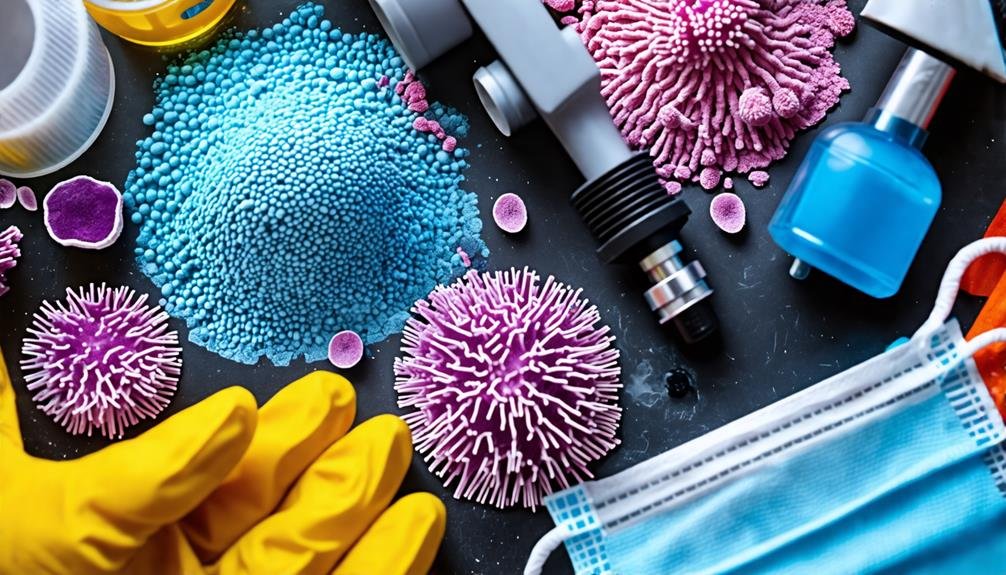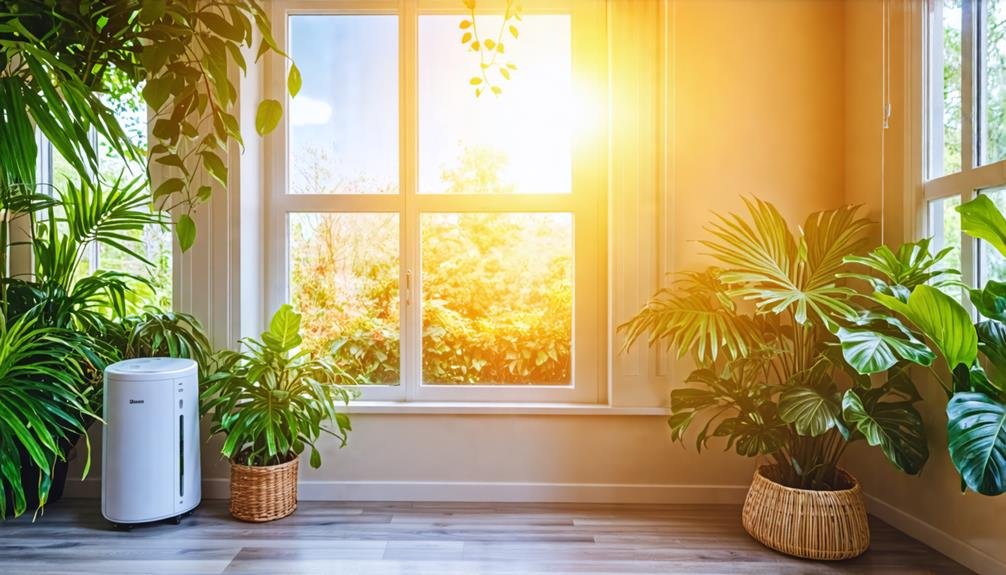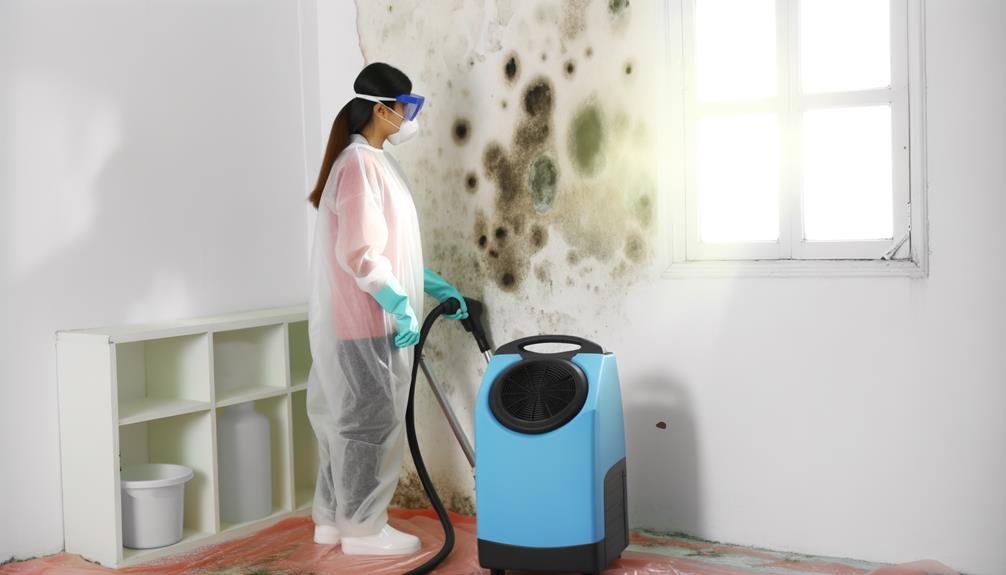Fairburn mold remediation prioritizes your safety with effective techniques tailored to combat mold growth. Start by identifying moisture sources and performing thorough inspections using visual assessments and thermal imaging. Use personal protective equipment, like respirators and disposable coveralls, during safe removal processes. Natural cleaning solutions, such as vinegar and baking soda, provide eco-friendly options that minimize toxic exposure while removing mold. Prevention is essential, so maintain low humidity levels and regularly inspect for leaks. These approaches guarantee a healthier living environment. Investigate further to uncover more strategies for effective mold remediation and prevention in your space.
Understanding Mold Growth

Mold growth occurs when moisture, warmth, and organic materials create an ideal environment for spores to thrive. Understanding the mold lifecycle is important for effective prevention and remediation. It begins with the release of spores, which can remain dormant until conditions become favorable to growth. Once moisture is present, these spores germinate, leading to the development of hyphae. This mycelial network can spread rapidly, consuming available organic matter and generating more spores.
To combat mold growth, moisture control is necessary. You need to keep humidity levels below 50% in your living spaces. Regularly check areas prone to dampness, like basements and bathrooms, for leaks or condensation. Utilizing dehumidifiers and ensuring proper ventilation can greatly reduce moisture levels, disrupting the mold lifecycle.
Additionally, addressing any water damage promptly is crucial. The longer moisture persists, the more likely mold will take hold. By actively managing your environment and maintaining moisture control, you can prevent mold from becoming a problem and protect your living space from the potential damage it can cause. Staying informed and proactive empowers you to maintain a mold-free home.
Health Risks of Mold Exposure
Exposure to mold can lead to a range of health issues, particularly for individuals with respiratory conditions or weakened immune systems. Mold can trigger mold allergies, causing symptoms like sneezing, runny nose, and itchy eyes. In some cases, prolonged exposure can result in more severe respiratory issues, including asthma attacks or chronic bronchitis.
Here's a brief overview of common health effects associated with mold exposure:
| Health Effect | Symptoms | At-Risk Individuals |
|---|---|---|
| Mold Allergies | Sneezing, itchy eyes | Individuals with allergies |
| Respiratory Issues | Coughing, wheezing | People with asthma |
| Infections | Fever, fatigue | Those with weakened immune systems |
It's essential to recognize these risks and take appropriate measures to mitigate exposure. If you notice mold growth in your home, addressing it promptly can help safeguard your health. By understanding the potential dangers of mold, you can make knowledgeable choices about your living environment and prioritize your well-being. Don't underestimate the impact mold can have on your health—awareness is the first step toward prevention.
Assessment and Inspection Techniques

When evaluating mold issues, you'll want to employ both visual inspection methods and air quality testing. Visual inspections help identify visible mold growth and potential moisture sources, while air quality testing provides essential data on spore levels in the environment. Together, these techniques form an all-encompassing approach to understanding the extent of mold contamination.
Visual Inspection Methods
A thorough visual inspection is essential for identifying potential mold growth and evaluating the extent of contamination in a given space. You'll want to begin by systematically examining areas prone to moisture, such as bathrooms, kitchens, and basements. Look for discoloration, peeling paint, or any signs of water damage, as these can indicate hidden mold problems.
Utilizing thermal imaging technology can improve your inspection. This method detects temperature variations on surfaces, allowing you to identify hidden moisture pockets that might not be visible to the naked eye. By pinpointing these areas, you can effectively target your remediation efforts.
Moisture mapping is another important technique. It involves measuring moisture levels in various building materials, helping you understand the extent of the issue. High moisture readings often correlate with mold growth, so knowing where these readings are highest can direct your next steps.
Incorporating these inspection methods guarantees a thorough assessment, enabling you to make educated choices about mold remediation. By identifying problem areas accurately, you'll empower yourself to take the necessary actions to create a safer, healthier living environment.
Air Quality Testing
Air quality testing plays a crucial role in evaluating mold presence and its impact on indoor environments, helping you identify potential health risks associated with airborne spores and contaminants. When you conduct air quality tests, you're not just checking for visible mold; you're reviewing the overall safety of your indoor air. This testing adheres to established testing standards, ensuring that results are reliable and actionable.
During testing, air samples are collected and analyzed for mold spores, mycotoxins, and other harmful particles. You might opt for both indoor and outdoor sampling to compare levels, which provides a clearer picture of your indoor air quality. Furthermore, consider using specialized equipment like air pumps and spore traps, which can capture a variety of air contaminants.
Once you receive the results, they can guide your next steps—whether it's to initiate remediation or implement preventive measures. Understanding your indoor air quality isn't just about mold; it's about creating a safe and healthy living space. By prioritizing air quality testing, you take an important step toward maintaining a mold-free environment that aligns with your desire for freedom and well-being.
Safe Removal Methods
When tackling mold removal, using safe methods is essential for your health and the environment. You should prioritize personal protective equipment, deploy HEPA filtration systems, and opt for natural cleaning solutions to effectively manage mold without causing harm. Each of these strategies plays a key role in ensuring a thorough and safe remediation process.
Personal Protective Equipment
Choosing the right personal protective equipment (PPE) is essential for ensuring safety and minimizing health risks during mold remediation. When you set out on this task, you need to prioritize your well-being by wearing appropriate protective gear. A well-fitted respirator is crucial, as it filters out harmful spores and prevents inhalation. Don't overlook protective eyewear that shields your eyes from irritants.
Long-sleeved clothing, gloves, and boots are also important components of your safety protocols. These items create a barrier between your skin and mold, reducing the risk of direct contact. Remember to choose gloves made from materials resistant to mold and chemicals, such as nitrile.
Moreover, consider using disposable coveralls to prevent contamination of your clothing. After completing the remediation, you can simply remove and discard them, ensuring that you don't carry any spores outside the work area.
HEPA Filtration Systems
Utilizing HEPA filtration systems during mold remediation considerably improves the removal process by capturing airborne spores and preventing their spread throughout the environment. These systems employ HEPA filters, which are designed to trap particles as small as 0.3 microns with an efficiency of 99.97%. This capability is essential for ensuring that your indoor air quality remains safe and free from mold spores.
When you implement HEPA filtration, you're not just addressing the visible mold; you're additionally tackling the microscopic spores that can lead to health issues. Consider these benefits of HEPA filtration systems:
- Enhanced Air Purification: HEPA filters remove allergens and irritants, promoting healthier living spaces.
- Reduced Mold Spores: By trapping spores in the filter, the risk of recontamination is minimized.
- Improved Odor Control: Many HEPA systems likewise include activated carbon filters to neutralize musty odors.
Natural Cleaning Solutions
Natural cleaning solutions offer effective and safe methods for removing mold without relying on harsh chemicals that can compromise indoor air quality. You can create homemade cleaners using common ingredients like vinegar, baking soda, and hydrogen peroxide. These substances not only tackle mold effectively but furthermore promote a healthier living environment.
For instance, a simple solution of equal parts vinegar and water can be sprayed directly onto moldy surfaces. Let it sit for an hour before scrubbing and rinsing. Baking soda mixed with water forms a paste that can likewise be an excellent abrasive cleaner for tough mold stains.
Moreover, consider incorporating crucial oils into your cleaning routine. Tea tree oil and lavender oil not only provide a pleasant scent but also possess natural antifungal properties. A few drops mixed with water can improve your homemade cleaners, making them even more effective against mold.
Using these natural methods empowers you to take control of your home's environment while minimizing exposure to toxic chemicals. By opting for homemade cleaners and crucial oils, you can maintain a clean, mold-free space that supports your well-being and freedom from harmful substances.
Prevention Strategies

To effectively prevent mold growth, it's essential to control moisture levels in your home through proper ventilation and regular maintenance. By being proactive, you can minimize the risk of mold infestations and guarantee a healthier living environment. One of the best strategies involves using mold resistant materials in areas prone to moisture, such as bathrooms and kitchens.
Here are some key prevention strategies to take into account:
- Install exhaust fans in high-humidity areas, like bathrooms and kitchens, to improve airflow.
- Keep gutters clean and make sure downspouts direct water away from your foundation to prevent leaks and dampness.
- Monitor indoor humidity levels; aim for a range of 30-50% to create an inhospitable environment for mold.
Eco-Friendly Products and Solutions
Eco-friendly products and solutions offer effective alternatives for mold remediation while minimizing environmental impact. When you're tackling mold issues, consider using biodegradable cleaners that break down naturally and don't harm ecosystems. These cleaners often contain plant-based ingredients, providing a safer option for your home and the environment.
Implementing sustainable practices during your remediation process is crucial. For instance, using vinegar or baking soda not only fights mold effectively but likewise keeps your indoor air quality high. Unlike harsh chemical solutions, these natural options won't release toxic fumes, ensuring a healthier living space for you and your family.
Furthermore, opting for eco-friendly mold removal services can further support sustainability. Many companies are now adopting green methods, utilizing low-VOC (volatile organic compound) products to reduce their environmental footprint. By choosing these alternatives, you're not only protecting your home but also contributing to a broader movement towards environmental consciousness.
Ultimately, adopting eco-friendly products and solutions helps you combat mold effectively while aligning with your values of freedom and responsibility toward the planet. It's a win-win scenario—your home stays clean, and the environment benefits, too.
Conclusion
To summarize, while some might think mold remediation is too complicated or costly, addressing mold issues promptly is vital for your health and home. By using safe and effective techniques, you can protect your indoor environment without overspending. Remember, investing in prevention and eco-friendly solutions not only safeguards your space but additionally contributes to a healthier planet. Taking action now guarantees a safer future, making it well worth the effort and resources.

